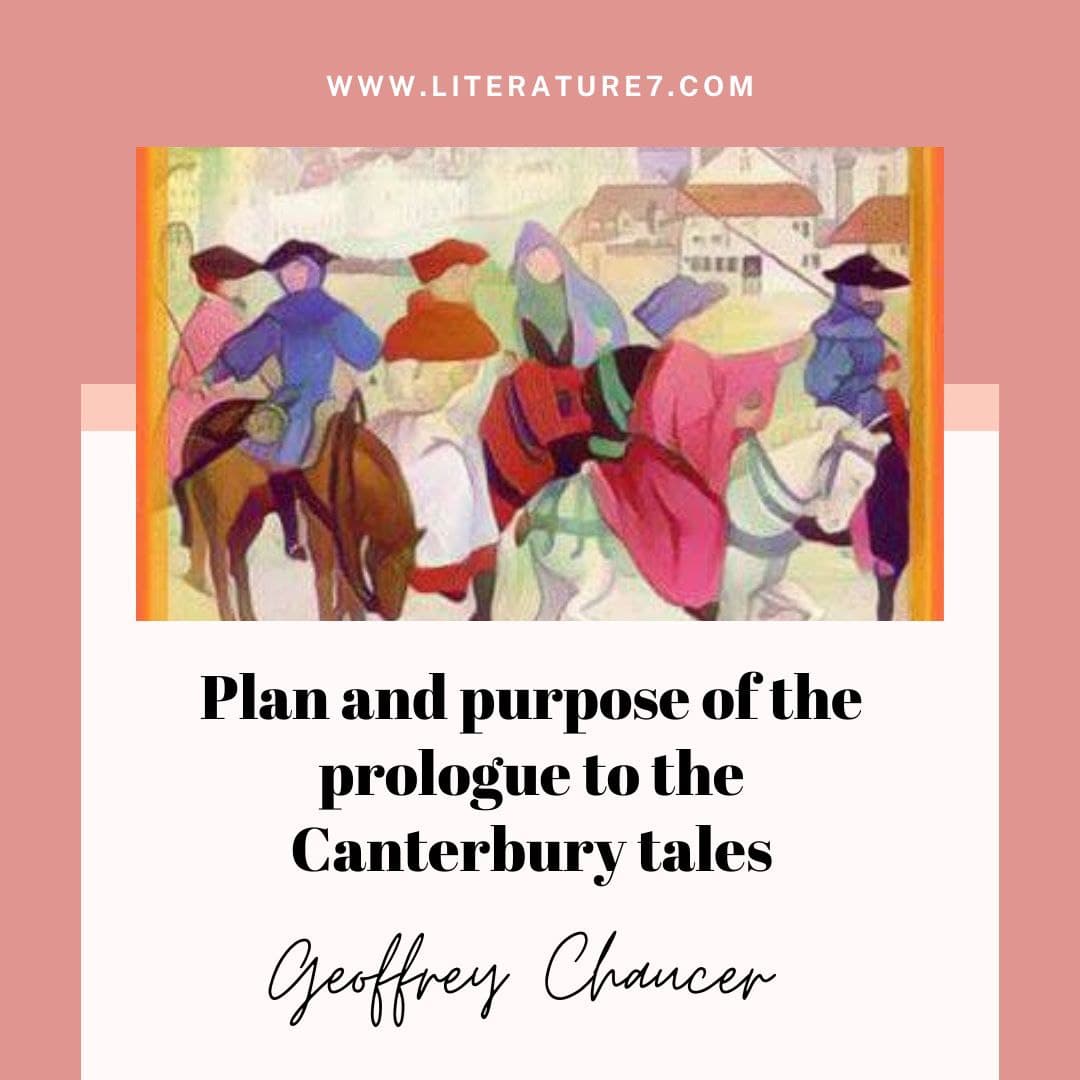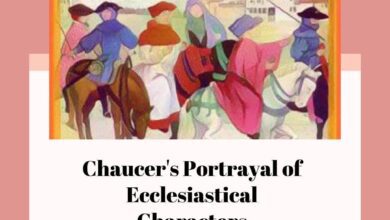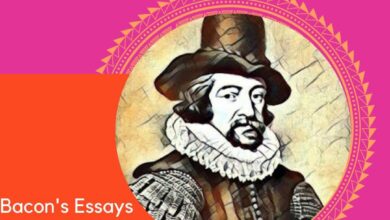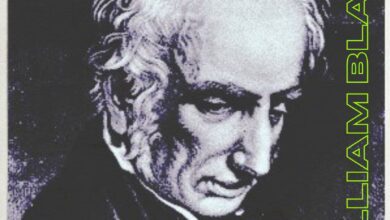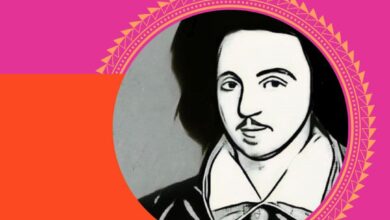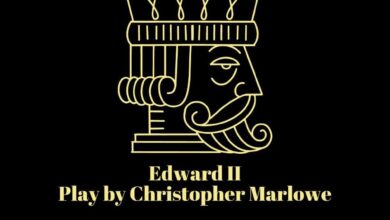Plan and purpose of the prologue to the Canterbury tales

Plan of the prologue to the Canterbury tales
The Prologue is so fascinating because it hints at the structure of The Canterbury Tales and paints a picture of national life. Boccaccio’s Decameron was an inspiration to Chaucer. However, Chaucer is more than Boccaccio’s model and adds an entirely new meaning to his work through his insight and perception and by his charming humor and humanism.
In the Prologue, the poet depicts himself as alighting, one spring evening in the Tabard Inn in Southwark, one of the suburbs located at the southern end of London Bridge, where the famous Elizabethan playhouses later appear, with Shakespeare’s being among them, were yet to emerge. Southwark was the location of the departure and arrival of any travel to the south of England, and particularly for pilgrimages to the shrine of St. Thomas a Becket at Canterbury.
A group that is planning this kind of journey meets in an inn. Chaucer meets them and is part of the participants. The pilgrim’s number is 32 in total, which includes the poet. There’s a Knight who has recently been from wars abroad that been fighting with the Turks and Prussians, fought in Prussia and Turkey, jousted in Tramisene, and was present during the battle of Alexandria. He’s an intelligent, kind, gentle, knightly adventurer and a type of the courteous, war-loving chivalrous man with a class war that was rapidly disappearing.
Read more Stream of consciousness novel in english literature
His son is with him, who is a young Squire with curly hair and a grey appearance and his white short-sleeved dress embroidered like a mead with white and red flowers. He embodies in himself the gifts and grace of a brilliant youth. The servant is a Yeoman, dressed in a green coat and hood and a peacock arrows in his belt, a mighty bow in his hand, and a silver-colored image of Saint Christopher on his chest. The Yeoman is a model of sturdy English Yeomanry, which humbled the glory of France, Crecy, and Agincourt with its grey goose shafts.
There’s a whole group of ecclesiastical characters representing the Church’s diverse concerns of medieval times. They are primarily satirical portraits, exposing in their materialism and worldliness the abuse which had crept into the Church which Wycliffe condemned. First of all, there is a Monk who is devoted to hunts and good cheer. His bald head shines like glass, and his bright eyes are dangling around his head. He rides a sleek brown horse and owns “many a dainty horse” in his stables. The sleeves of his coat are decorated with fur around the wrists. His hood is fastened beneath his chin with a gold love-knot.
Read also Plot Construction of Dr. Faustus
Another person in the group includes “Madame Eglantyne,” the Prioress. She is a teacher of young ladies, speaking French “after the school of Stratford-atte-Bowe.” She is stunning with her table manners, and she can influence the court’s manner of conduct as well as the formal behavior in the court. Other ecclesiastics are caterpillars of the Church. The Friar is intimate with the friendly Franklins innkeepers, noblewomen, and despising lazars and beggars.
The Summoner, the repulsive man with “fire-red cherabin face,” the Pardoner, with his bag of pardons that “come from Rome all hot,” and pieces of pig’s bone and cloth which he sells as relics of holy saints. Chaucer treats evil churchmen with a good-humored tolerance. He creates a better effect by placing them beside them as a model of the true shepherd of the Church, a “poor Parson,” partly under the influence of Wycliffe because Wycliffe was preparing for reform of the Church.
Chaucer depicts the persona of the Parson, poor in the world’s goods, however “rich of holy thought and work,” with a loving and reverent touch. The brother of the Parson travels with him-a Plowman, a “true swinker and a good,” who help his poor neighbors without pay and treats them like a friend. He is a reminiscence of the character of Piers the Plowman.
A group of other figures can be seen on the canvas. There’s an English Shipman from the west-country, who was a symbol of the brave seamen, half merchant-sailors half smugglers and pirates who already created a swarm of terror on the high seas. They also helped to establish the country’s future naval and commercial dominance.
There’s a humble Clerk from Oxford who rides an unfathomably lean horse as a rake, dressed in a threadbare cloak, who spends everything that he can beg or borrow to fund his studies. He represents that passion for learning that was bubbling up throughout Europe and culminated with the Renaissance. The Merchant is dressed in a Flemish beaver’s hat, riding an equestrian horse, hiding as best as much as he can in his self-confidence and self-importance, the fact that he’s in debt.
Related Chaucer’s contribution to the growth and development of the English language
There’s a group of guild-members wearing the dress of their guild, who are all worthy of being aldermen. Together with the merchants are a representation of the mercantile and manufacturing class. They point to the future rise of England as a major commercial power. The Wife of Bath is almost a modern female figure, hit off with masterful humor and realism- a permanent human type. She has had “husbands five at church-door” and, though ‘somdel deaf,’ hopes to live to marry several others. She rides an ambler that has spikes as well as scarlet-colored hoses at her feet, and on her head, a hat as wide as the buckler.
At supper, the host of the Tabard Inn proposes that on their way to Canterbury, each of them will share two stories from this side and two stories in their return journey to ease the boredom of the journey. He also offers to accompany the pilgrims and act as the chief of ceremonies. The other participants are required to accept his judgment on which one is the best storyteller, and the one who is the most engaging of them is served a meal at the general expense.
All the pilgrims agreed upon the decision, and they began their journey in the early hours of the following day. Lots are drawn to determine who will be the first to tell the story, and the lot falls to the Knight.
Purpose of the prologue to the Canterbury tales
The purpose of Chaucer’s Prologue was to express the social scene of fourteenth-century England. In his portrayal of English society, the author chooses the typical persona of every class and profession in contemporary England and paints his character with a painter’s brush and the lively interest and humor of a humanist. This gallery of portraits depicts every realistic hue of modern-day social life.
